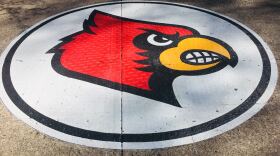If you’re driving on I-265, just past the Ford Plant, you’ll see a sign that reads: “Exit 35, Cincinnati 1.2 kilometers.”
There’s an English measurement, too, in parenthesis. The exit is 3/4ths of a mile away -- but for an entire stretch of Louisville interstate, it’s like you’re in a country that actually uses the metric system as the primary form of measurement.
And several Curious Louisville listeners wanted to know why.
The story begins in the late 1960s. The tech field was booming, scientific strides were being made, and during that time, there was a push among some American government and science professionals to shift to the metric system. They argued it would aid in global commerce and in the exchange of new ideas.
Over the next decade, the U.S. government inched towards the switch.
In 1975, President Gerald Ford signed the Metric Conversion Act, which declared the metric system "the preferred system of weights and measures for United States trade and commerce."
To be clear, the Act didn’t actually do anything; President Ford emphasized that the conversion was completely voluntary. But for the next few years, “Schoolhouse Rock”-style films produced by the government like this were distributed for viewing in schools and professional settings:
In 1977, Kentucky Governor Julian M. Carroll named a metric task force of 33 educators to ensure the metric system would be the dominant measuring system in state schools by 1980.
But that didn’t happen. The little national excitement surrounding the conversion had dissipated. Most people went on measuring their lives in inches, miles and gallons.
Until the 1990s.
At that time, some government agencies, including the Department of Transportation, planned to require metric units by 2000.
This was ultimately canceled by the 1998 Transportation Equity Act.
“But during that time, the signs you saw on I-265 were scheduled for replacement,” said Andrea Clifford, a spokesperson for the Kentucky Transportation Cabinet. “The Kentucky Transportation Cabinet chose to list the mileage in metric since the state would soon be converting to that system.”
But with no federal mandate, it was decided that Kentucky would remain with the English measurement system.
“Since the signs are very expensive to fabricate, the Transportation Cabinet opted to leave them in place since they contain English units as well,” said Clifford.
And, Clifford said, they will remain in place until it comes time to replace the signs -- which will be a while, as they aren’t really showing any wear and tear.
For local proponents of the metric system, that isn’t a bad thing.
Caroline Doyle, a biology professor at Bellarmine University, said the metric system is part of the language of science.
“It is an absolute must in science communication,” Doyle said. “Everything is a factor of 10, and it is this beautiful, universal system.”
Doyle said she’d like to see more emphasis put on teaching the metric system in school -- and she’s not the only one. There are groups, like the U.S. Metric Association, dedicated to advocating for a shift in measurement systems.
In the most recent issue of their newsletter, “Metric Today,” writers talked about a future in which the country had fully converted to the metric system.
Right now, it seems improbable. But if the shift ever occurs, Louisville -- with its stretch of metric-measured highway -- will be miles (or, uh, kilometers) ahead of the rest of the country.
Listen to the story here:
(Can't listen? Here's a transcript!)
Ask your own question in this form, or at curiouslouisville.org.






